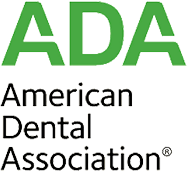Antibiotic Therapy
Systemic Antibiotic Therapy
Low Dose Antibiotics
Local Antibiotic Therapy
Systemic Antibiotic Therapy
Systemic antibiotics are drugs that, when given, affect the whole body. Normally they are administered in pill form when used in periodontal treatment. Periodontists use systemic antibiotics to treat acute infections, such as a gum abscess (gum boil), and also before treatment when patients have certain medical conditions, such as joint and heart valve replacements.
Systemic antibiotics are sometimes also recommended after bone regeneration procedures and when implants are placed. This is done to make sure there is no infection during the early healing stages, which are critical with these two techniques.
As a rule, for most routine periodontal conditions, systemic antibiotics are not necessary. In some cases there may be very specific harmful bacteria that can be eradicated with oral antibiotics. For these cases, we take a culture and give a short-term treatment of antibiotics specific to kill the bacteria found in the culture.
In addition, cases where traditional treatment does not produce the expected results, the mouth may be cultured to find out what specific bacteria are present. This will help guide us on which antibiotic to use. For more information on the microbacteria testing kit, please choose from the following:
Microbacteria Testing Kit Brochure
Results Report
Low Dose Antibiotics
There has been interest in the use of low dose antibiotics. The dose is so low that the drug does not act to kill bacteria, but rather to change the way the body responds to infection.
One interesting effect of low dose antibiotics is they reduce the body's production of collagenase, an enzyme that destroys gingival tissues.
We all need some collagenase as older tissue is removed and replaced with new tissue. However, in periodontal disease, there seems to be an overproduction of collagenase, causing the body to destroy healthy gum tissue.
The antibiotic doxycycline was found to combat these enzymes, even in doses so small that there was not an antibiotic effect. The advantage of the smaller doses is a great reduction in the chance of resistant bacterial strains forming.
Periostat is a capsule of 20mg of doxycycline, and clinical studies have shown that patients who take two capsules daily have a reduction in clinical inflammation. The studies were limited to nine months, so there is no official recommendation to take the product for a longer period.
From a practical standpoint, it seems that Periostat can be taken indefinitely. However, some preliminary work indicates that there is a positive residual effect for three months after stopping the drug, so some practitioners recommend taking Periostat three months on, three months off.
The daily 40mg doses are so low as not to qualify as an antibiotic, and there is no known effect on the pocket bacteria. Indications for Periostat are generally seen in recall patients who are not responding well, and have generalized inflammation in spite of reasonable oral hygiene.
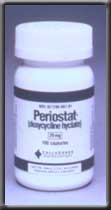
Local Antibiotic Therapy
Arestin
There has been much interest in local antibiotic delivery. If an antibiotic can be delivered directly to the pocket, without the patient having to take oral doses, there are far fewer side effects, and fewer chances of resistant bacteria forming.
In addition, with direct local delivery, the concentration of the antibiotic at the diseased site can be 100 times greater than taking the medication orally. However, it is important to note that all local delivery antibiotics are recommended as adjuncts to scaling and root debridement, and not as stand-alone treatments.
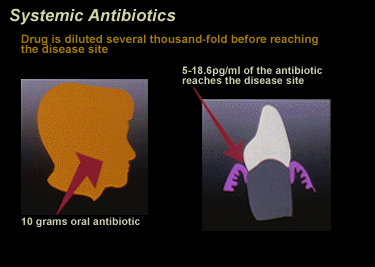 Systemic antibiotics are diluted before reaching the pocket. With local application, the antibiotic is inserted directly into the pocket, resulting in much higher concentrations.
Systemic antibiotics are diluted before reaching the pocket. With local application, the antibiotic is inserted directly into the pocket, resulting in much higher concentrations.Studies have shown decreased probing depth, reduced bleeding, and improved attachment levels when Arestin is used in conjunction with scaling and planing.
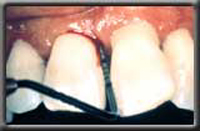 Pocketing and bleeding on probing
Pocketing and bleeding on probing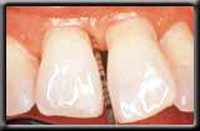 Pocket reduction and lack of bleeding after Arestin.
Pocket reduction and lack of bleeding after Arestin.Arestin
Arestin consists of small spheres of minocycline, a derivative of tetracycline. This drug is very effective in killing the bacteria that are thought to cause periodontal disease.
The spheres, which look like a fine powder, are contained in a small blunt plastic tube, and are injected into the pocket. This requires no anesthesia.
The spheres are bioadhesive, and stick to the pocket wall, where they slowly release minocycline over a 14-to-21-day period. Because the spheres are also biodegradable they do not require removal.
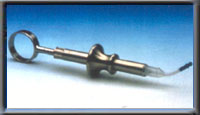 Delivery syringe containing Arestin (minocycline)
Delivery syringe containing Arestin (minocycline)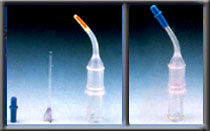 The plastic syringe consists of a cap, a plunger, and the Arestin, which is expelled by the plunger
The plastic syringe consists of a cap, a plunger, and the Arestin, which is expelled by the plunger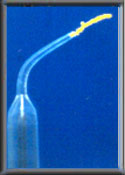 Close-up of Arestin powder being expelled from syringe tip
Close-up of Arestin powder being expelled from syringe tip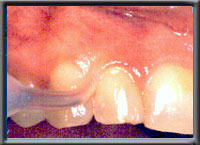 Arestin being expelled under the gum and into the periodontal pocket
Arestin being expelled under the gum and into the periodontal pocket

